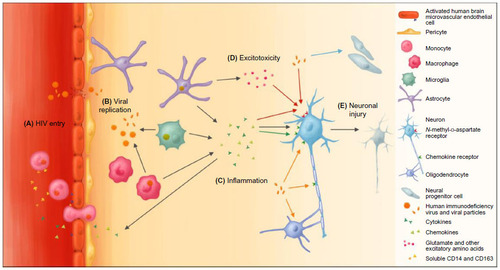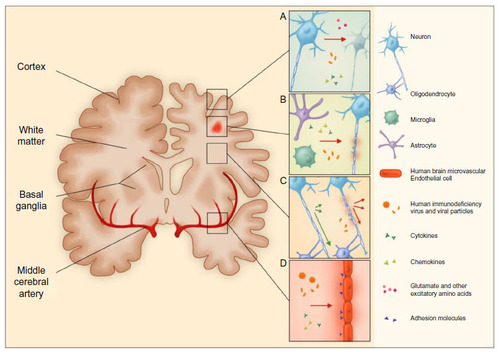Figures & data
Figure 1 The effects of HIV on the cells of the central nervous system.
Notes: (A) HIV entry. HIV enters the central nervous system within infected monocytes or as free virions or viral particles. This process is facilitated by HIV-induced monocyte and endothelial activation, astrocyte dysfunction, and structural damage to the blood–brain barrier. (B) Viral replication. HIV infects and activates macrophages and microglia in the perivascular space, the main site for viral replication. (C) Inflammation. Activated microglia, macrophages, and astrocytes contribute to the release of proinflammatory cytokines and chemokines, which cause further influx of immune cells and mediate neuronal injury. Conversely, some inflammatory mediators can also promote neuronal survival (green arrow). (D) Excitotoxicity. HIV induces release of glutamate and other excitatory amino acids from neurons and astrocytes. Together with viral proteins and HIV-induced chemokines, these substances overstimulate N-methyl-d-aspartate receptors, causing excitotoxicity (red arrows). (E) Neuronal injury. Insults by HIV proteins (orange arrows), excitotoxicity, and inflammation lead to axonal injury and neuronal apoptosis. Furthermore, HIV affects neural progenitor cells, impeding repair and brain growth (blue arrow).

Figure 2 HIV-induced cerebral injury.
Notes: (A) Volume loss. HIV-infected children have lower brain volume, which may be caused by neuronal loss and impaired brain growth. (B) White-matter lesions. White-matter lesions correspond to sites of glial proliferation and myelin injury. (C) Altered white-matter diffusivity. Diffusion along a myelinated axon bundle is anisotropic along the axons (green arrows). Even in normal-appearing white matter of HIV-infected children, reduced axial and increased radial diffusivity (red arrows) may reveal myelin and axonal injury. (D) Vascular changes. HIV infection is associated with structural and functional vascular changes, in part mediated by endothelial activation and dysfunction with increased expression of adhesion molecules, as well as low-grade inflammation and a hypercoagulable state.

Table 1 Selected laboratory biomarkers in HIV neuropathogenesis
